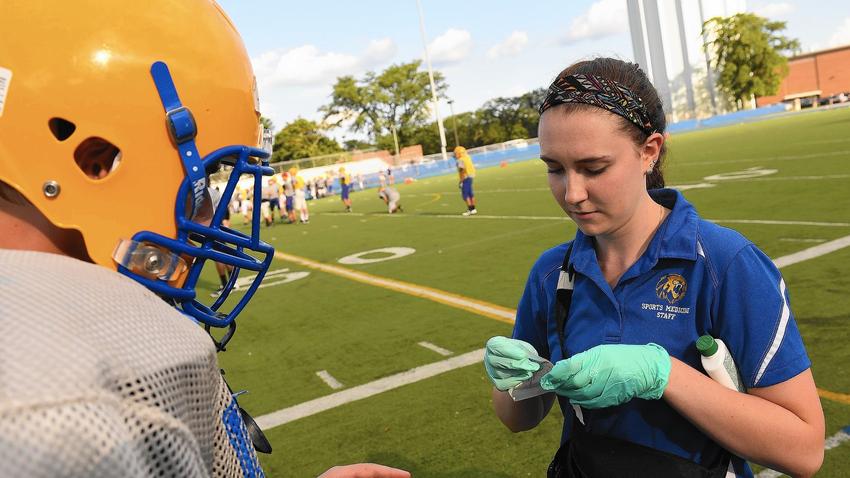
Training and instinct come into play just as much for student athletic trainers as the athletes they assist at Lyons Township High School.
“We offer basic first aid to the athletes,” said La Grange senior Kaylah O’Dea, who is starting her third football season as a student trainer.
“When the boys get hurt, we’re the first ones they come to,” O’Dea said. “That’s an awesome responsibility, to be trusted that much.”
Students can become certified in basic first aid, professional rescue, cardiopulmonary resuscitation and taping techniques, said Bob Fichter, who teaches sports medicine and health and oversees the program.
“We discuss emergency response, spine boarding and concussion protocol,” Fichter said. “They know their roles, what they can and can’t do.”
What sets LT’s program apart from other high schools is the educational component and opportunity to learn from experienced peers, Fichter said. Twenty-seven returning and new students were involved in the fall sports season as of Aug. 17, the first day of school.
“Some schools might have two or three students volunteer to bring water and help on the sidelines, but to have a student athletic training club is different,” he said. “In two weeks, we’ll be doing an in-service training to give everyone who’s interested the chance to join.”
Peer leadership also is important to the program developed since 1976 under Rich Carey, Fichter said. Upperclassmen teach new students coming into the program.
Remaining calm and reassuring when a student is injured is crucial, said Western Springs senior Sarah Kate Weibel, starting her third year in the program.
“There was a student last year with a bone sticking out of his arm. I focused on calming him down,” Weibel recalled. “I said, ‘don’t look at it. Look at me.'”
O’Dea said she, too, tries to reduce an injured athlete’s stress.
“I don’t say anything drastic. I just talk about their day and keep them distracted until somebody comes to help,” she said.
Other duties are more mundane, like filling water bottles or ice baths and taping ankles, wrists, fingers, arches, knees, thumbs and shins, Weibel noted.
When asked whether she felt appreciated, Weibel said, “When the football players don’t have their water, they notice. Yeah, we’re appreciated.”
La Grange junior Juliana Halpin said having her arches taped by the student trainers definitely helps her run cross country for a second season.
Another cross country runner, Corey Kline, a La Grange Park junior, stopped in the training room for ice to recover from calf strain and cuts after a fall unrelated to running. He said he hopes to return to practice in another week or two.
“They’ve been very helpful,” Kline said. “I haven’t been in here too much, thankfully, but when I did, the experience has been good.”
Athletic Director John Grundke said the student trainers are integral to the success of the school’s athletic program. It’s helpful to have more students with training watching the athletes at practices and games who are able to assess a situation and call for help.
“They’re our first line of defense. They know all the athletes,” Grundke said. “We give each of them a radio so we get first responders there more quickly.”
Student trainers said they became involved for a variety of reasons.
“I like helping people with injuries. I’m an athlete, and I know how easy it is to get injured,” said Weibel, who plays soccer in the spring. “It’s also cool to be behind the scenes.”
O’Dea said she, too, likes being at the center of the action.
“I like having court side seats for games and being on the sidelines for football,” she said.
Willow Springs sophomore Julia Gilman said she joined halfway through the football season a year ago.
“I learned a lot about taping and injuries, and I was the only (student) trainer for most of the season during the winter for freshman boys basketball. I love being on the sidelines.”
Students are asked to commit to two of the three sports seasons and attend practices or games three days a week, Fichter said. Each student is assigned a particular sport, but will assist athletes at all levels, so that not just seniors are assigned to varsity players, he said.
“Students have the environment and resources to take this further if they want to, and some go on in sports medicine,” he said. “This program is for those who are interested in the health professions and for those who like helping people. We have so many avenues for students to learn.”
Kristine Vins, who graduated in 2006, is among students who took advantage of the program and now works with Fichter as a certified athletic trainer.
After working all three sports seasons for four years at LT, Vins graduated in the athletic trainer program from the University of Illinois at Urbana-Champagne and began working at LT in 2011.
“I wanted to get into medicine and wasn’t sure in what capacity,” Vins said. “Then I really got into it and could see what we do here and never looked back.”
ORIGINAL ARTICLE:
http://www.chicagotribune.com/suburbs/la-grange/news/ct-dlg-student-trainers-tl-0827-20150823-story.html